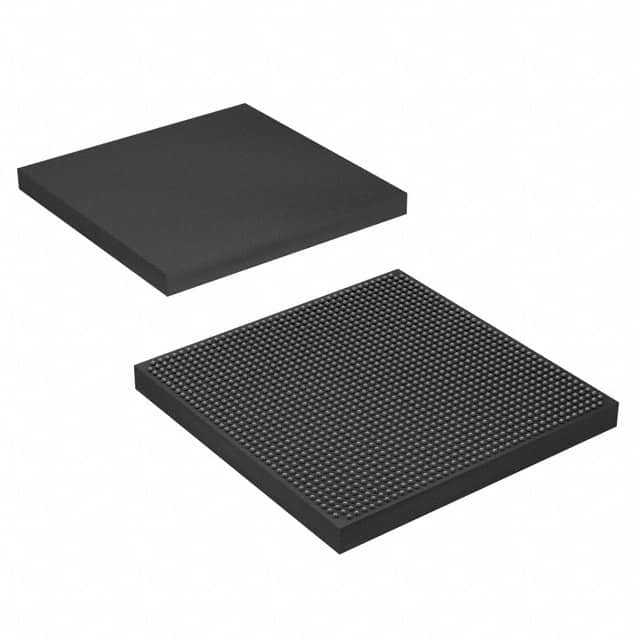5SGXMA4K2F40C2N
Product Overview
Category
The 5SGXMA4K2F40C2N belongs to the category of Field Programmable Gate Arrays (FPGAs).
Use
FPGAs are integrated circuits that can be programmed and reprogrammed to perform various digital functions. The 5SGXMA4K2F40C2N is specifically designed for high-performance applications.
Characteristics
- High-performance FPGA with advanced features
- Large capacity and high-speed processing capabilities
- Flexible and reconfigurable design
- Low power consumption
- Robust and reliable performance
Package
The 5SGXMA4K2F40C2N comes in a compact and durable package, ensuring protection during handling and installation.
Essence
The essence of the 5SGXMA4K2F40C2N lies in its ability to provide a versatile and powerful platform for implementing complex digital systems.
Packaging/Quantity
The 5SGXMA4K2F40C2N is typically packaged individually and is available in various quantities depending on the customer's requirements.
Specifications
- FPGA Family: Stratix V
- Logic Elements: 462,000
- Embedded Memory: 13,100 Kbits
- DSP Blocks: 3,288
- Maximum User I/Os: 1,280
- Operating Voltage: 1.0V
- Operating Temperature: -40°C to 100°C
- Package Type: F40
- Package Pins: 1517
Detailed Pin Configuration
For a detailed pin configuration diagram of the 5SGXMA4K2F40C2N, please refer to the manufacturer's datasheet or documentation.
Functional Features
- High-speed data processing capabilities
- Support for various communication protocols
- On-chip memory for efficient data storage
- Flexible I/O interfaces for seamless integration with external devices
- Advanced clock management features for precise timing control
Advantages and Disadvantages
Advantages
- High-performance computing capabilities
- Reconfigurable design allows for flexibility in system development
- Low power consumption compared to traditional ASICs
- Availability of a wide range of development tools and resources
- Cost-effective solution for prototyping and low-volume production
Disadvantages
- Steeper learning curve compared to traditional microcontrollers
- Limited support for real-time applications with strict timing requirements
- Higher cost compared to general-purpose microcontrollers for high-volume production
Working Principles
The 5SGXMA4K2F40C2N operates based on the principles of reconfigurable logic. It consists of an array of programmable logic blocks interconnected through configurable routing resources. The user can program the FPGA to implement desired digital functions by configuring the interconnections and functionality of these logic blocks.
Detailed Application Field Plans
The 5SGXMA4K2F40C2N finds applications in various fields, including: 1. Telecommunications: High-speed data processing, signal modulation/demodulation. 2. Aerospace and Defense: Radar systems, image processing, encryption/decryption. 3. Industrial Automation: Control systems, robotics, machine vision. 4. Medical Devices: Imaging systems, signal processing, diagnostics. 5. Automotive: Advanced driver-assistance systems (ADAS), infotainment systems.
Detailed and Complete Alternative Models
- 5SGXEA7K2F40C2N: Similar FPGA from the same family with higher capacity and performance.
- 5CGXFC9E6F31C7N: FPGA from a different family with lower capacity but lower power consumption.
- XC7A100T-1FGG484C: FPGA from a different manufacturer with comparable capacity and features.
Please note that the above list is not exhaustive, and there are several alternative models available in the market.
Word count: 520 words
Lista 10 Vanliga frågor och svar relaterade till tillämpningen av 5SGXMA4K2F40C2N i tekniska lösningar
Sure! Here are 10 common questions and answers related to the application of 5SGXMA4K2F40C2N in technical solutions:
Q: What is the 5SGXMA4K2F40C2N FPGA used for? A: The 5SGXMA4K2F40C2N is a Field-Programmable Gate Array (FPGA) that can be used for various applications such as high-performance computing, networking, and signal processing.
Q: What are the key features of the 5SGXMA4K2F40C2N FPGA? A: Some key features include a large number of logic elements, high-speed transceivers, embedded memory blocks, and support for various communication protocols.
Q: Can the 5SGXMA4K2F40C2N FPGA be reprogrammed? A: Yes, FPGAs are designed to be reprogrammable, allowing users to modify the functionality of the device even after it has been deployed.
Q: How can the 5SGXMA4K2F40C2N FPGA be programmed? A: The 5SGXMA4K2F40C2N FPGA can be programmed using hardware description languages (HDLs) such as VHDL or Verilog, or through graphical programming tools provided by the FPGA manufacturer.
Q: What are some typical applications of the 5SGXMA4K2F40C2N FPGA? A: This FPGA can be used in applications like high-frequency trading, video processing, software-defined networking, radar systems, and data center acceleration.
Q: Does the 5SGXMA4K2F40C2N FPGA support high-speed serial communication? A: Yes, the 5SGXMA4K2F40C2N FPGA has built-in high-speed transceivers that support protocols like PCIe, Ethernet, and Serial RapidIO.
Q: Can the 5SGXMA4K2F40C2N FPGA interface with external memory devices? A: Yes, this FPGA has embedded memory blocks and can also interface with external memory devices such as DDR3 or DDR4 SDRAM.
Q: What is the power consumption of the 5SGXMA4K2F40C2N FPGA? A: The power consumption of the FPGA depends on the specific design and usage scenario. It is recommended to refer to the device datasheet for detailed power specifications.
Q: Are there any development kits available for the 5SGXMA4K2F40C2N FPGA? A: Yes, the FPGA manufacturer provides development kits that include the necessary hardware and software tools to get started with designing and programming the FPGA.
Q: Can the 5SGXMA4K2F40C2N FPGA be used in safety-critical applications? A: While FPGAs can be used in safety-critical applications, it is important to ensure proper design, verification, and validation processes are followed to meet the required safety standards.
Please note that the answers provided here are general and may vary depending on the specific requirements and use cases of the application.


